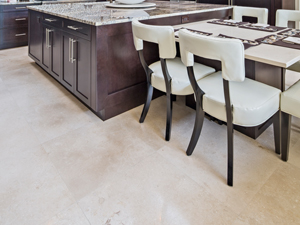April 21, 2022

How to Clean and Protect Limestone Floors
Limestone floors are relatively easy to maintain and can bring a timeless elegance to any kitchen, bath, or living area. However, limestone can become dull and dirty with time and use. Here are some tips to keep your floors looking their best.Dealing with Dull Spots and Etching
First and foremost, it's important to use a pH-balanced cleanser that is formulated specifically for marble and limestone floors. Chemical abrasives and acidic cleansers can cause etching, a phenomenon that occurs when a calcium-based stone like limestone, travertine, or marble comes in contact with anything acidic and creates what looks like a cloudy white watermark. Spills from acidic liquids like vinegar, soda, tomato sauce, and lemon juice can also cause etching. Limestone polishing compounds or etch removers for getting rid of light etching are available for DIY use on polished (not honed) limestone. Ask us about specific product recommendations. For more information, view How to Polish Out Etch Marks. Heavier etch marks, that is, any etching that has a texture, as well as etching that covers larger areas, should be removed by an experienced stone care professional.Getting Rid of Stains
Stains that leave dark spots on natural stone can usually be removed with a poultice. A poultice safely absorbs stains from the surface without discoloring the stone. You can buy a ready-to-use poultice or make one yourself. For more information, visit our Stain Removal Application.The Problem with DIY Finishes
Over-the-counter finishes and lacquers can create that desired "wet look" and a temporary guarantee to protect your floors, but in reality, they may actually cause more harm than good. These finishes eventually flake away, leaving your floor vulnerable to damage from foot traffic. They can also block the pores of limestone and cause premature degradation and dullness over time.Sealing Your Limestone Floors
Limestone floors may need to be sealed periodically, to inhibit staining. Keep in mind that sealers will wear away over time, so it's best to have sealed limestone floors cleaned and resealed by a professional restoration contractor every two years or so.Restoring Worn Floors to Like-New
If your limestone floor is worn, scratched, or damaged, don't replace it. One of the most wonderful features of natural stone is that your floor can be professionally refinished to look brand new again.Keeping Them Looking New
With the right care and maintenance your limestone floors can always look like the day they were installed and give you a lifetime of beautiful service.